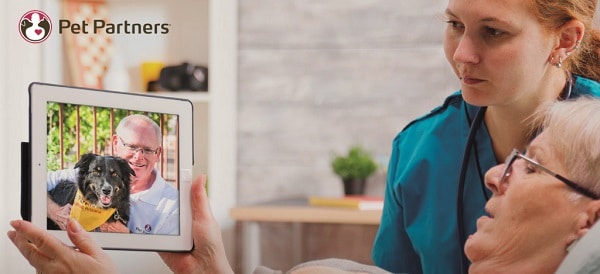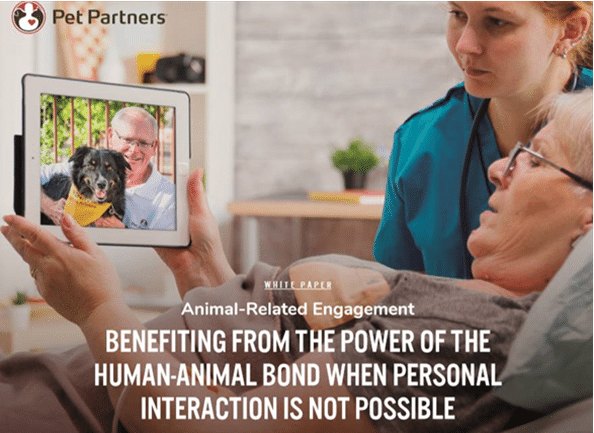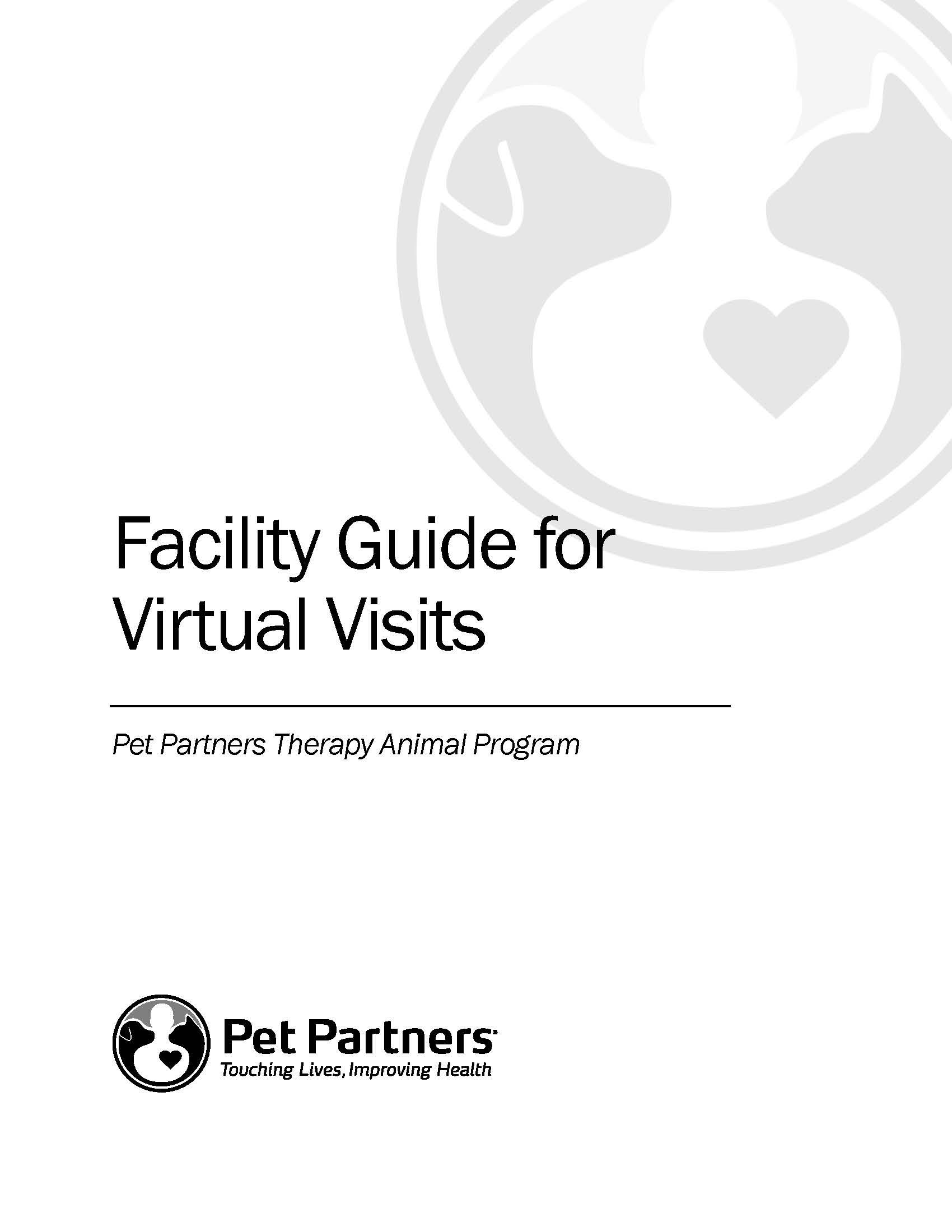



With the sudden impact of COVID-19 on the therapy animal community, Pet Partners found ourselves in a challenging situation: the love of animals was needed more than ever, but the ability to bring therapy animals to people was largely cut off. We immediately began considering the countless ways in which animals impact our wellness, and what we could be doing to unleash the power of pets in this unprecedented time.
Within the first few days of the pandemic’s global impact, we noticed a fascinating new phenomenon: Pet videos and pictures were being shared and enjoyed at rates higher than ever. Many of our dedicated handlers also started offering video calls and checking in via email and social media with the facilities and people they normally visit , finding new ways to bring their pets to the facilities that have come to depend on them.

The response to these initial virtual engagement efforts was overwhelmingly positive, and it became clear that this kind of interaction was making a difference in people’s lives! As an organization, we knew that not only would we need to empower our handlers to offer these services to their communities, but we also wanted to better understand how these experiences might be explained in existing human-animal interaction literature. Pet Partners has deep roots in leaning into the support of the scientific community, and we are committed to basing all new programs we offer on a solid foundation of empirical evidence.
As we looked at what the research had to say about these experiences, we were thrilled to discover numerous ways that animal-based stimuli have been studied. Many of these projects were investigated in conjunction with therapy animal programming, measuring the impact of therapy animal interaction as compared to interactions with stuffed animals, robotic pets, and even animal-based activities such as crafts and puppy videos. The results of these preliminary investigations were promising, suggesting that some populations might benefit from animal-based engagement at rates similar to the benefits of therapy animal interaction.(1)
There were even studies of this nature that took place outside of the therapy animal community. For example, some researchers have spent time focusing on the specific impact of watching animal videos. In these studies, it was found that engagement with this kind of content not only elevates mood, but it can also impact more complex variables such as work productivity and interpersonal relationship satisfaction(2,3,4).
 As we began to compile data on this subject for our recently published white paper on the topic, we turned to some of the AAI field’s top leaders, who also serve on the Pet Partners Human-Animal Bond Advisory Board. They offered some thoughts about how we can approach these extraordinary times and still bring the benefits of the human-animal bond to people.
As we began to compile data on this subject for our recently published white paper on the topic, we turned to some of the AAI field’s top leaders, who also serve on the Pet Partners Human-Animal Bond Advisory Board. They offered some thoughts about how we can approach these extraordinary times and still bring the benefits of the human-animal bond to people.
Dr. Aubrey Fine provided tremendous hope, saying, “In a time of restricted visitations, we don’t have to discontinue our connection, but must search for alternatives to share the tremendous benefits derived from the bond.”
Dr. Leslie Stewart offered more support, stating, “Although there is no true substitute for in-person human-animal interaction, we rise to the challenge to adapt our animal-assisted intervention to virtual formats.” In the ARE white paper, you will find full letters from both professionals who graciously shared ideas for how they are creatively offering services during this challenging time.
Bolstered by empirical evidence, professional support, and the anecdotal testimonies from many innovative handlers, Pet Partners released a comprehensive new initiative: Animal-Related Engagement (ARE). ARE is defined as follows:
Any engagement opportunity that allows participants the benefits of the
human-animal bond by encouraging the remembrance of feelings that
are commonly associated with interaction with an animal.
Within the ARE initiative, handlers, practitioners, and facilities will find a multitude of suggested animal-based activities along with supportive materials to assist in these efforts.
 Facilities interested in virtual visits can download our Virtual Visit Guide for information on how to set up video-based visits with therapy animal teams with which they already have relationships.
Facilities interested in virtual visits can download our Virtual Visit Guide for information on how to set up video-based visits with therapy animal teams with which they already have relationships.
Pet Partners handlers have come up with a multitude of creative ways to maintain their connections with clients and facilities and provide the benefits of the human-animal bond, even when they aren’t able to visit in person. Learn more about these alternative options in our blog post.
Perhaps you are a Read With Me™ team with a history of encouraging young readers in your community, or an educator or librarian who has hosted reading programs at your organization. Check out our We Are All Ears program, which provides ideas and activities for kids and families to inspire reading at home.
 Other ARE materials include a downloadable coloring book, a suggested reading list, and arts and crafts ideas that can positively impact your community in multiple ways.
Other ARE materials include a downloadable coloring book, a suggested reading list, and arts and crafts ideas that can positively impact your community in multiple ways.
The sky is the limit when it comes to the creative ways in which your love for animals can be infused in ARE, and we can’t wait to hear about how our handlers, facilities, and practitioners expand this initiative in the weeks to come.
To learn more about ARE, view the recording of our Facebook Live event about this subject.
 While we realize that nothing in this world could replace the impact of visiting with a therapy animal face to face, we also know that the power of the human-animal bond is bigger than any one circumstance. We are excited to offer this initiative to provide support for the effects of animals beyond in-person therapy animal visits, and to continue supporting a global community of animal lovers in a way that casts a wider net than ever before.
While we realize that nothing in this world could replace the impact of visiting with a therapy animal face to face, we also know that the power of the human-animal bond is bigger than any one circumstance. We are excited to offer this initiative to provide support for the effects of animals beyond in-person therapy animal visits, and to continue supporting a global community of animal lovers in a way that casts a wider net than ever before.
References